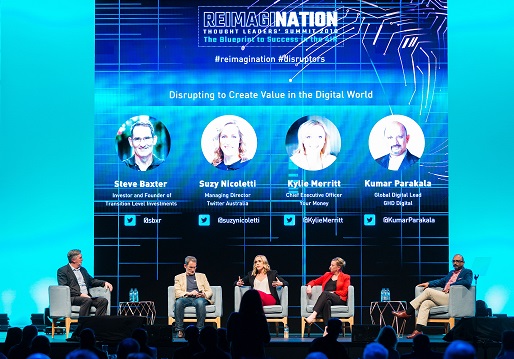Policy-makers may be attempting to steer the digital economy with regulations, but change-resistant executives can achieve the same outcomes by leveraging new technologies to better engage with their customers, a panel of industry experts has advised.
“Emotion is the new currency,” Suzy Nicoletti, managing director of Twitter Australia, told the audience during a panel session at the recent ACS Reimagination Leaders’ Summit 2018.
“We’re in a time and place where technology really dictates our full reality, and customers are absolutely central to this whole journey,” she said. “They are the ones that are driving value creation and value destruction.”
Forward-leaning companies were engaging with customers earlier in the product launch cycle, she said, soliciting feedback over social media and shaping their campaigns around customers’ expressed opinions and desires.
Shifting a business to focus on customers often requires major cultural change, said Kumar Parakala, global digital lead with consultancy GHD.
“Digital transformation is business transformation,” he explained, “and business transformation is cultural transformation. And if you don’t recognise that culture could be strategy, you can have the best strategy in the world, but you won’t be able to get anywhere.”
The compromise had been to develop an agile strategy but pair it with a “heavily execution focused approach, with equal emphasis on cultural change”.

The panel debates disruption at the Reimagination Thought Leaders' Summit. Photo: Kat Stanley Photography
Regulation vs innovation
Such transformation, in other words, must be driven from within the organisation – and not from without, as one panellist emphatically pointed out.
Shaping digital strategy according to customer demands was philosophically opposite to a regulatory environment that, entrepreneur Steve Baxter said, had proven completely inadequate at setting the terms for the fourth industrial revolution.
“If anyone in this country thinks we’ve done ourselves a favour by regulating ourselves to the position we are in now, I think you’re on the wrong planet,” he said, noting that Australia’s extensive financial-services regulatory framework had complicated venture capitalists’ ability to get funds where they are needed.
“The amount of detail and garbage that we go through, thanks to ASIC, to basically take investment funds from high net-worth investors is ridiculous,” Baxter explained.
“Our default stance of ‘regulate something’ is crazy; it hasn’t worked and all it’s doing is making everything more expensive, and actually removing innovation.”
“Regulation says you can’t put that square peg into that round hole – which is why regulation and innovation can’t exist in the same room.”
Regardless of attempts by regulators, businesses will benefit most from proactively leveraging the Internet to improve the efficiency of every part of their operation, said Kylie Merritt, chief executive officer of newly-launched Nine Network-Sky News joint broadcasting venture Your Money.
Pointing to the escalation of automation capabilities and the increased opportunities for customer engagement on digital platforms, Merritt said digital transformation has “completely transformed everything that we do”.
“It allows you to be far more efficient and accurate in what you’re doing,” she explained. “And there are a lot of cost savings that you can then plough back into making content and investing in journalism.”
The team behind Your Money built the venture to be digital from scratch “and to make sure the two parts of the business speak to one another completely.”
People inside and out
As much as technology is a driver for change, ultimately businesses need to remember that it is the people they employ who will benefit most from the way those technologies are used.
That’s why Baxter, for one, focuses his investment energies on the people that come to him rather than the ideas they are pushing.
“We rarely invest in an idea,” he said. “We usually invest in someone who has built something, that along the way could be very disruptive. It’s the pace of adoption that tells us whether [it is resonating with potential customers].”
Those customers are also people, whose expectations and feedback must be managed to ensure that company-driven disruption is meeting customers’ needs.
This dynamic is particularly pointed in the broadcast space, Merritt noted: “It’s a real fight for audiences, and you have to give people exactly what they want,” she said. “You can’t just keep putting out stuff like they did 20 years ago when people had no other choice.”
Driving delivery of that product was demanding different relationships between disruptors and their customers, with campaigns often involving everyone from the CEOs down to marketing and editorial teams.
“You have an integration throughout the whole business,” Merritt said.
Yet for all the interactivity and individuality that technology allows, Parakala warned that companies also need to be wary of becoming too attentive – and, in the process, being distracted from their core focus.
“I often ask: ‘if everyone is innovating, why aren’t we moving more forward?’,” he explained. “The answer is that we aren’t always actually creating value, if there are 300,000 people creating their own meaning and definition of what innovation means.”
Managing outcomes in this disruptive climate required a bifurcated strategy, he said: “You really need to segregate the businesses that are focused on innovation from the businesses that are focused on margin maximisation; they have a very different mindset about creating value, and their metrics need to be very different.”
Ultimately, disruption success in the fourth industrial revolution will require broad participation amongst every aspect of industry – and engagement with the people they employ.
“This is one of the most transforming times of human society,” said Parakala. “The challenge is that not everybody is able to see the massive change that we are going through.”
“Leaders running large organisations are hardwired to think in a certain way, and digital is asking them to think in a completely different way. And that is a huge challenge.”




.jpg)





